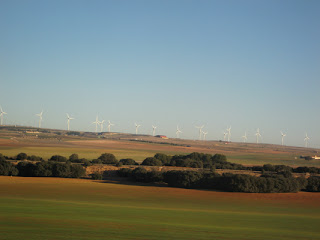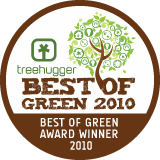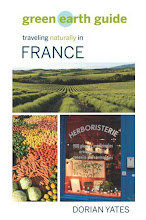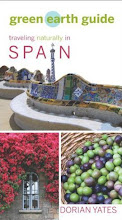




Bayeux is an ancient town in the Normandy region of northern France filled with old stone houses and walls. Founded 2000 years ago, it has many buildings still standing from 1,000-1500 ad including a large cathedral from 1077. Home to the famous Bayeux tapestry, a wool-in-linen embroidered masterpiece spanning over 200 feet, the tapestry tells the story of William the Conqueror’s (Duke of Normandy) conquest of England in 1066. The tapestry museum is well worth the 7 euro entry fee which includes a great audio guide.
Bayeux somehow managed to escape damage from both the Hundred Years’ war, as well as World War II even though it is only a few miles from the d-day beaches lining the Normandy coast. Museums, tours and cemeteries commemorating World War II surround the area, as well as Omaha, Utah, Juno and Gold Beaches. In Bayeux there is Le Memorial Des Reporters, a joint effort between Bayeux and the organization Reporters Without Borders, honoring freedom of the press and journalists from around the world that have lost their lives covering wars since 1944, including a single headstone for the famous war photographer Robert Capa who took extraordinary photographs of the D-day landing – standing alongside the troops as they came off the boats.
Historically known for its lace-making, ceramics, and its apple products, Bayeux boasts many local artisans carrying on the traditions of lace-making, embroidery, porcelain and ceramic making, woodworking, stone sculpture and even a small umbrella company. Local apple products are abundant here including Calvados, an apple liquor, as well as cider, jelly, juice and other goodies. Apple products made from local orchards surrounding Bayeux can be found at Cave Cidrocle Lecornu, Place Charles de Gaulle close to the cathedral, open April through September from 10-7:30; October through March just in the evenings 5- 7:30pm (www.lecornu.fr).
Bikes can be rented year round at the Le Verger de L’Aure, impasse de L’Islet, conveniently located across from the Bayeux Tourist office; Tel: 02 31 92 8916; open 8am-8:30 pm year round. A booklet detailing 19 walking or biking trails around Bayeux is available at the tourist office for 7euros. The Jardin Public de Bayeux, in the northwestern corner of the town, has 400 trees including an old weeping Beech listed as an historical monument (www.mairie-bayeux.fr). In the summer, you can spend over two hours walking through Le Labyrinthe de Bayeux in Mosles a few miles northwest of town (www.labyrinthe-bayeux.com).
Bayeux has seven, second-hand and antique stores selling things from traditional antiques to World War II artifacts, which locals still dig up on the nearby cliffs and beaches. Lovely, English speaking Patricia Cowling runs a tiny store, Brocante de Jolies Choses, filled with treasures on rue Larcher across the street from the post office ( 7 Bis rue Larcher; Tel: 06 25 71 2463).
While there are no health food stores in Bayeux, there are in surrounding towns, accessible if you have a car. Fresh produce, cheeses and bakeries are abundant and the Bayeux market, known for its excellent produce and products, is held on Saturday mornings in Place Saint Patrice. A smaller market is on Wednesday mornings on rue Saint Jean.
The local youth hostel in the heart of the old Bayeux Village is right across from the park Place Charles de Gaulle. It is in a historical building comprised of some old and more recently renovated sections. My room had a large French window overlooking an old walkway and terrace, an old stone wall and beyond, trees filled with singing birds. The wood and bamboo furnishings were comfortable and the beds were made with the traditional rolled duvets. The hostel, while quiet except for the lovely bird sounds, was pretty empty this time of year. Since the walls are thin, I can imagine a not so contemplative mood when the rooms are full, the windows open, and there is late summer night partying. The Hostel is part of the Hostelling International Network, www.fuaj.org and is called Family Home, 39 rue du General de Dais, Bayeux, Tel: 02 31 92 1522; Fax: 02 31 92 5572 (they have no email or web page – you must book by fax or post) Beds are 19 euros/night.
There are tour buses to the various D-day beaches that run in the range of 45 euros, but you can take local buses for a fraction of the cost. From Bayeux village you can take the #70 bus to the American Cemetery and monument at Omaha beach, a thirty-minute bus ride, for 2 euros one way. In the winter there is only one bus each way, but in the summer there are more options.
Omaha beach is impressive: a large beautiful beach, that doesn’t look like a battleground, but rather a resort beach. It is a protected area and the cemetery and monuments sit high above on a plateau. The acres of white crosses and stars of David in the cemetery emphasize the magnitude of what happened on June 6 and 7 1944. The beach was not what I expected. I imagined a grittier scene, with scattered wreckage and rocky shores. Instead I found a pristine beach with seashells, golden sand, dramatic clouds and an aura of significance.
I find Europe to be comforting, like an old woman who has seen everything: the land and many buildings here have born witness to wars, floods, earthquakes, different political regimes, different religious beliefs, and yet here it still is, for better or worse, a testament to the tenacity of the human spirit and the earth from whence we come.























































